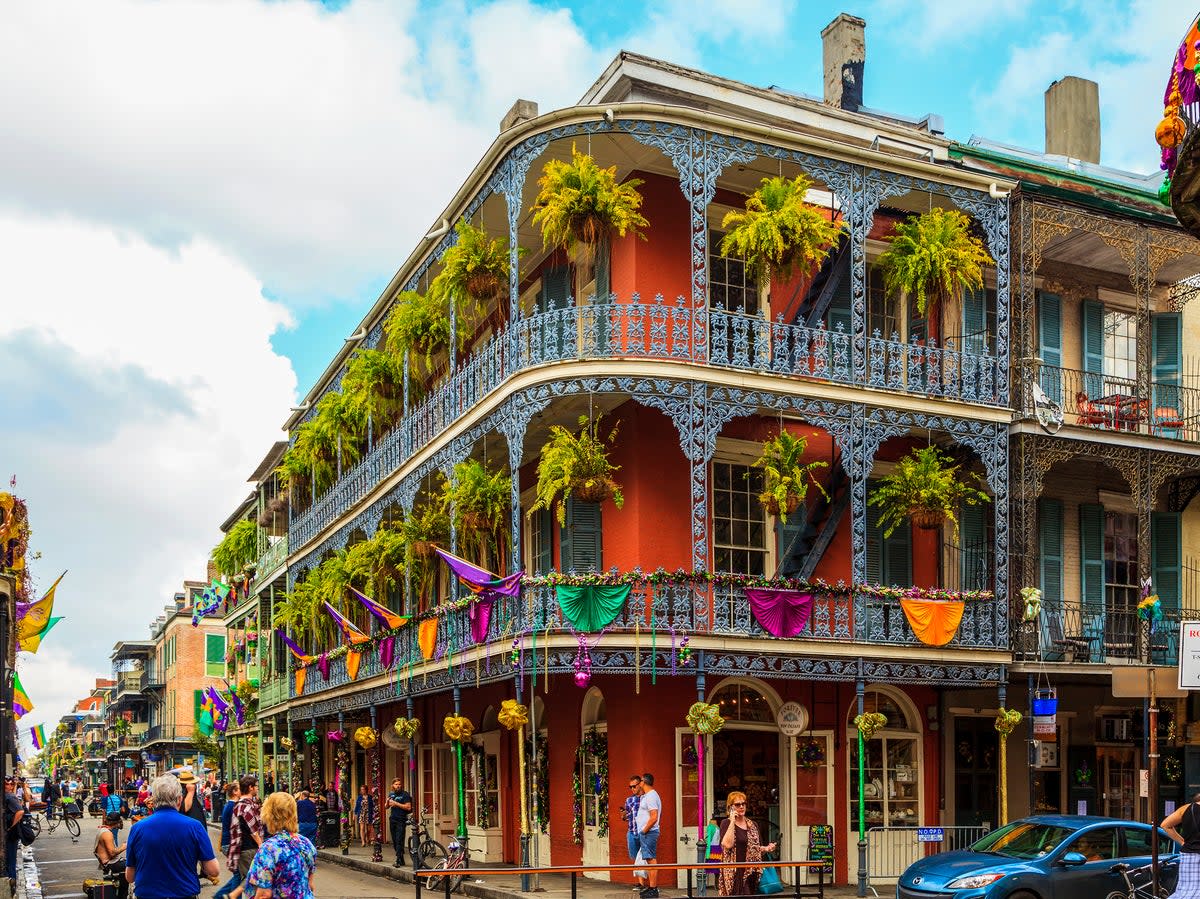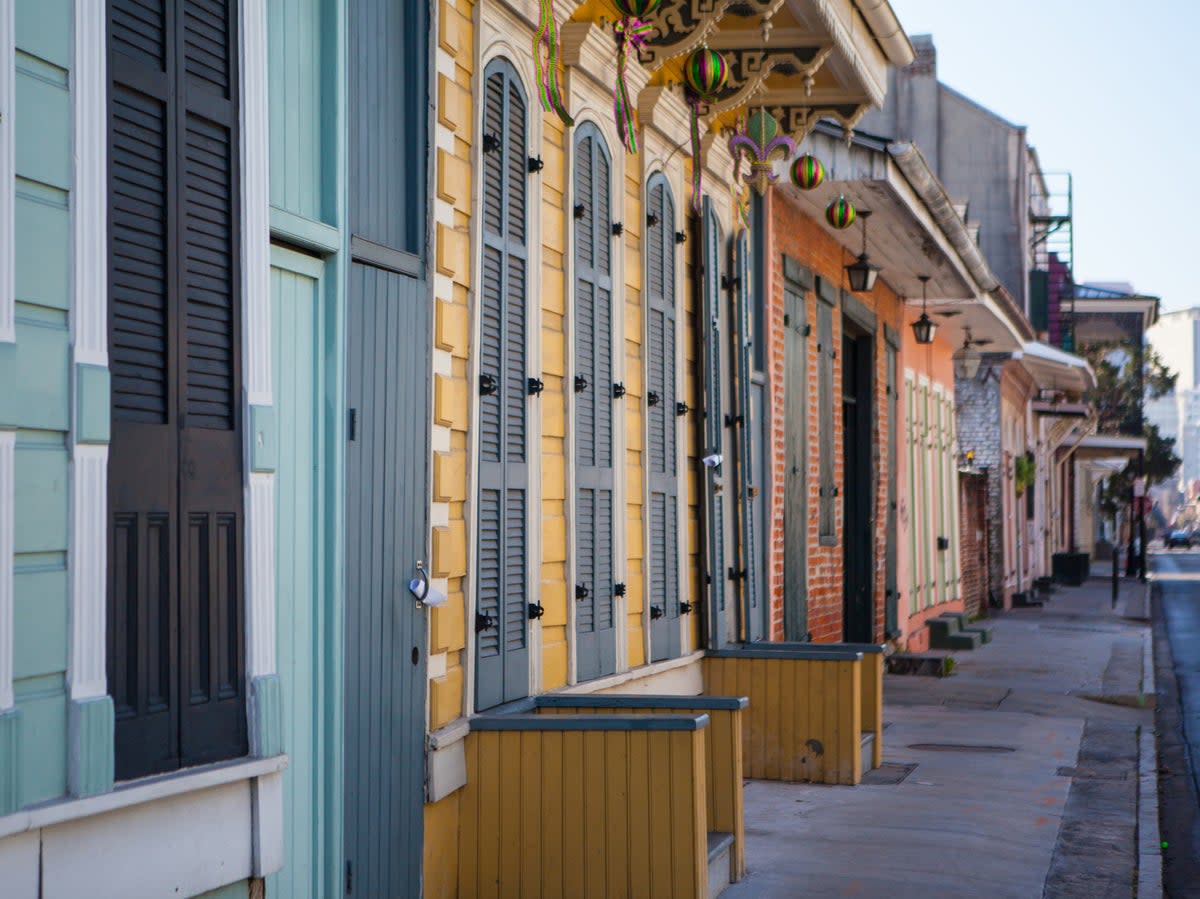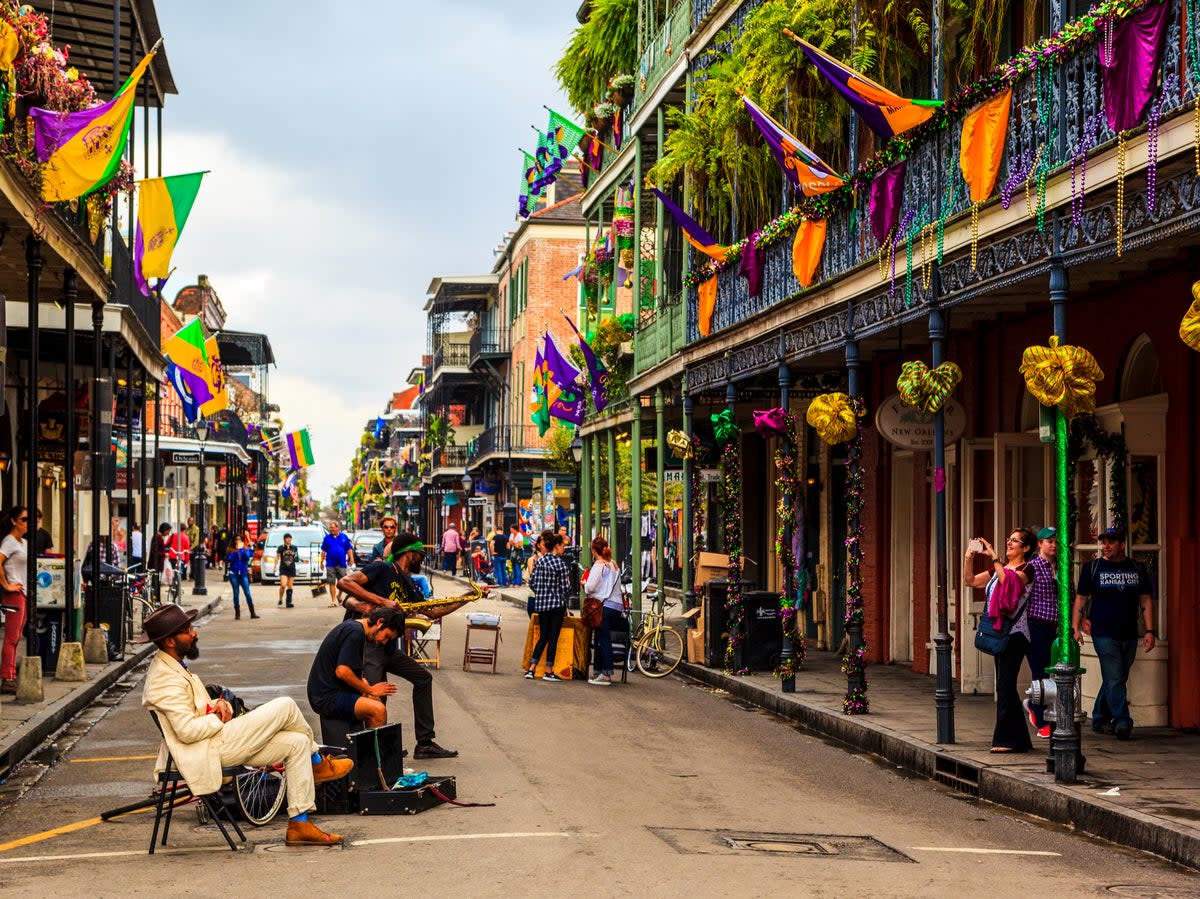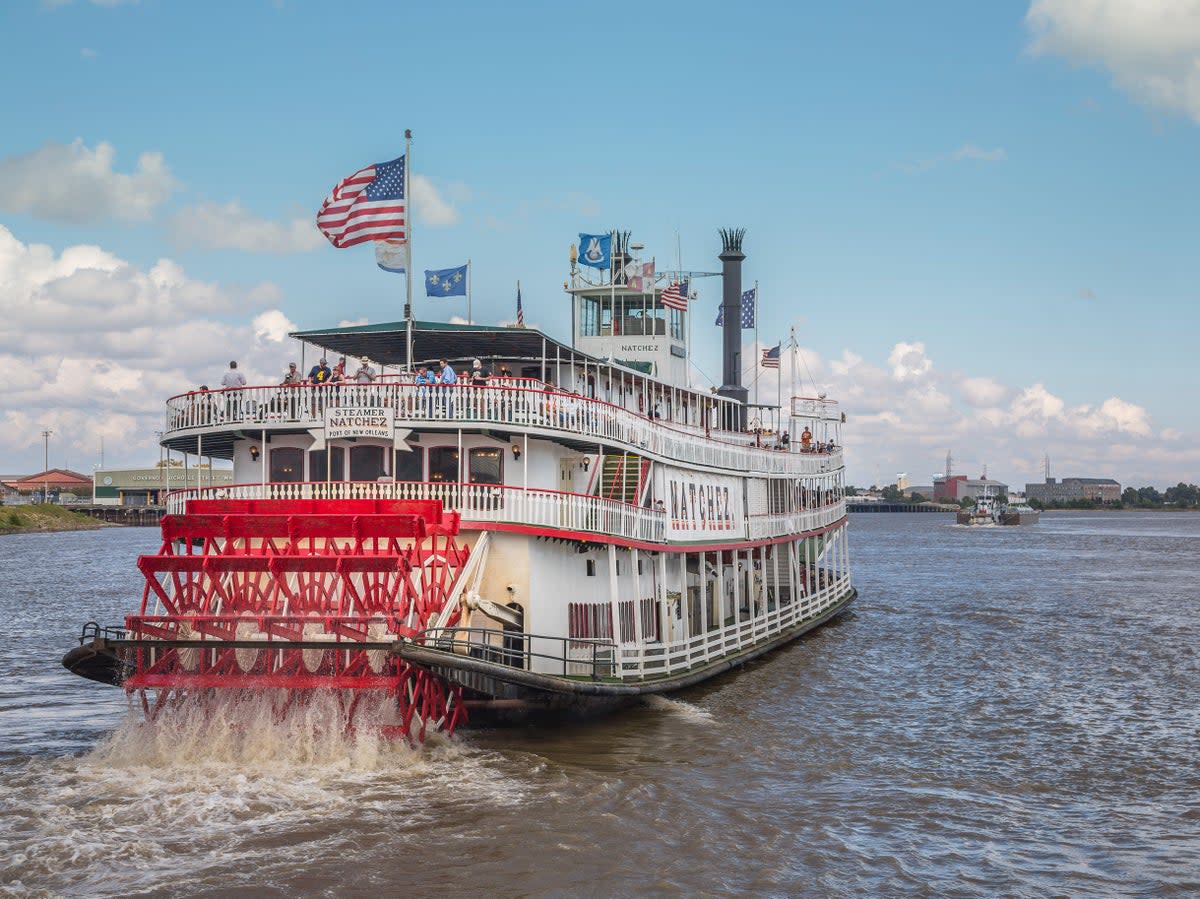How to spend a day in the French Quarter, New Orleans’ fun-loving, jazz-inflected neighbourhood

To many people, the French Quarter epitomises New Orleans, aka NOLA. Street parties, dazzling parades, cigar-chomping jazz virtuosos playing in dimly lit clubs and time-patinaed buildings, their characterful wrought iron balconies dripping in ferns and flags, are the kernel of the city’s soul. Simply wandering the streets is an experience in and of itself. There’s always something going on, something to see or an event to attend.
The French Quarter is deceptively small. Sprinkled along a bend of the Mississippi River as it snakes towards the Gulf of Mexico. Bound by Canal Street to the south, North Rampart Street to the west, Esplanade Avenue to the north and the Mississippi River to the east makes it just 14 blocks by six, laid out in their original grid pattern, unchanged since the early-18th century.
The name French Quarter is misleading in that many of the buildings date from the late-18th century, after the two New Orleans fires of 1788 and 1794 destroyed over 80 per cent of the city. By that point, French colonisers had been replaced by the Spanish, who rebuilt much of the NOLA that survives today. Bourbon Street marks the rambunctious centre, while the northern blocks are genial residential areas containing many of the best-preserved buildings.

Do
Pace the old grid
The French Quarter is at its most graceful in Jackson Square, dominated by the tri-spired façade of St Louis Cathedral. Next door, the Presbytère exhibits an array of whimsical and flamboyant Mardi Gras costumes. One room also takes a look at the destructive imprint of hurricanes on the city. On the other side of the cathedral sits the Cabildo, formerly the Spanish colonial government’s headquarters and now housing a local history museum. Visit to get a keen insight into the various cultures and races, whose worlds combined in NOLA to create such a singular city.
Read more on USA travel:
From Jackson Square, follow the old city grid northeast to the daily French Market, where food, souvenirs such as Mardi Gras masks and local art are on sale. Head away from the Mississippi from here, where the streets are at their most genteel. Don’t expect to see the French flag in the French Quarter. Instead, the NOLA tricolore comes in purple, green and gold: the official colours of Mardi Gras. On reaching Bourbon Street, drop one street south onto Royal Street where you might catch musicians, such as the fabulous Doreen J Ketchens and her band (who play in the street outside the stunning LaBranche House), doing their thing.
Get jazzed up

Propping up the northeast corner of the French Quarter is New Orleans Jazz Museum. This multi-storey museum, inside the neoclassical former US Mint building, tracks jazz music, the birth and evolution of which was central to New Orleans, through the decades. Exhibits include an exploration of how the drum kit, as we know it, was improvised into existence here, exultations of the biggest names in NOLA jazz and plenty of chances to listen to their works. Time your visit to catch a live performance in their top-floor performance space (shows, listed on the website, are included in your ticket).
When you’re done learning about the history of jazz, you might want to see how it’s getting on today. When closed, you’d likely walk right past Preservation Hall, thinking it was a derelict and unloved old building. But if you catch a jazz performance in New Orleans only once, make it here. The nation’s best and brightest jazz musicians perform between two and five shows an evening here. Tickets often sell out in advance.
Meet the Mississippi
Originally a port city on the Mississippi River, New Orleans has long had an uneasy association with the water. While this snaking behemoth is steeped in a certain romanticised history, it has also caused plenty of pain, not least of all when breaking through the levees designed to protect the city from storm surges and flooding. Nevertheless, strolls and picnics along Moonwalk promenade through Woldenberg Riverfront Park are the perfect antidote for those wanting a break from the intensity of the French Quarter.

Get even closer to the mighty river by getting on it. To see the steamboat Natchez, with its white balconies and red paddlewheel, is to understand the grace of the southern states. Daily two-hour cruises up and down the Mississippi are often accompanied by a live jazz band, some historical narration, and an optional buffet and drinks.
Eat
Mr. B’s Bistro
Tucking into a bowl overflowing with authentic Creole food is as much an attraction in New Orleans as the Mississippi itself. But buyer beware, there are many tourist-tipsy places in the French Quarter that have lost their edge while upping their prices. Mr. B’s Bistro is still right on the money, however, with loaded plates of sautéed crawfish tails and fettuccine, greased with smoked tomato butter, and seafood gumbo packed with shrimp and crab from the Gulf of Mexico.
Irene’s
Naming restaurants after the proprietor is common practice in these parts. You’ve got Adolfo’s, Brennan’s and Elizabeth’s; they’re all fine establishments. Then you have Irene’s, a traditional-style Italian restaurant with refined wood panelling, a piano bar to tap into the musical legacy of the French Quarter and a way with their fish dishes akin to sorcery. The oysters aren’t bad either. Save space for the Bananas Foster, a dessert invented in New Orleans.
House of Blues
Food in the French Quarter is frequently accompanied by a live band. And if you’re keen to switch things up from jazz for a while, blues and rock are on the bill at the House of Blues. The painted wooden entrance and reverential, bas-relief ceiling carvings of the top players gives this place a temple of music vibe. Mercifully for vegetarians, there are a couple of good options available, such as the vegan burger, in a city not known for its meat-free dishes.
Drink
Fritzel’s European Jazz Pub
Bourbon Street is the kind of place you might not enjoy unless you lean into it; a twisted Disneyland for adults, with all the finesse of an Ibizan bachelor party at 2am, albeit with a soundtrack provided by some of the finest musicians in America. A good place to start is Fritzel’s, where the jazz is generally groovy, attracting a calmer, music-loving clientele.
Bourbon Street after dark
After a few libations and some swingin’ jazz tunes, Bourbon Street is your oyster (or crawfish, if we’re keeping it local). Highlights include the Old Absinthe House, where the American football helmets hanging above the bar make an absurd sort of sense, especially after a few glasses of the aromatic green elixir. The further northeast along Bourbon you go, the less party-heavy the place becomes. One of the standout bars in the neighbourhood is Lafitte’s Blacksmith Shop Bar, which is rumoured (although branding superlatives in the States are to be taken with a pinch of salt) to be the oldest building currently used as a bar in the country.
Ramos gin fizz
Technically, it’s one street over from the French Quarter, but sipping a Ramos gin fizz at The Sazerac, bar of the Grand Roosevelt Hotel, is an essential NOLA drinking experience. The drink contains orange flower water, lemon juice, lime juice, sugar and gin, naturally. Although it’s the cream and egg white that give the drink its frothy character, but only after being vigorously shaken for a good few minutes.
Shop
Royal Street antiques
It may only be one block south of Bourbon Street, but Royal Street is a far classier affair, with dozens of antiques shops specialising in rare pieces and fine art. At the higher end of the scale is M.S. Rau selling anything from antique canes and perfume bottles to genuine Louis XIV cabinets. For a good browse, there’s Keil’s Antiques, which has been around for a while itself, in business since 1899.
Local artwork
Also on Royal Street is a range of art galleries, often run by the artists whose work is on show. Examples include Rodrigue Studio, where you can pick up copies of the instantly recognisable blue dogs of George Rodrigue. Gallery Rinard is owned and run by Matt Rinard, whose playful artworks are rooted in French Quarter life. Meanwhile the Angela King Gallery showcases a well-curated range of artworks from artists based in the wider Louisiana state and beyond.
Stay
Hotel Monteleone
It’s hard to imagine a hotel of Monteleone’s size and grandeur fitting into the French Quarter. After all, the 570 rooms, which include around 50 luxury suites, sound enough to fill a good proportion of the neighbourhood. In business since 1886, there is plenty of historic charm laced throughout, including a Belle Époque-style carousel bar. You can also expect excellent breakfast beignets (a local take on the fried pastries) and freshly renovated rooms with high ceilings.
Hotel St. Marie
One of the highlights of staying in the French Quarter is the opportunity to call one of the unique 18th-century buildings home for a day or two. At Hotel St. Marie, the best rooms even offer access to your own private, wrought-iron balcony overlooking the street. These are highly sought after during Mardi Gras, given that the hotel is less than a block away from Bourbon Street.
Hotel Provincial
It might not equate to a night at the museum, but thanks to its listing on the National Register of Historic Places, everything from the façade to the rooms of Hotel Provincial maintains a wistful sense of yesteryear. Rooms contain period features such as original fireplaces and antique wooden furniture. The building envelops a former courtyard, which has been repurposed into a pool area. There’s also a café and bar on site.
Read more: Best Hotels in New Orleans
Getting there
Direct flights from London Heathrow to New Orleans’ Louis Armstrong International depart three to five times a week, taking roughly 10 hours. Indirect flights (often via London) from additional UK airports, including Manchester, Glasgow and Belfast, last around 13 hours.
Read more on the best USA hotels